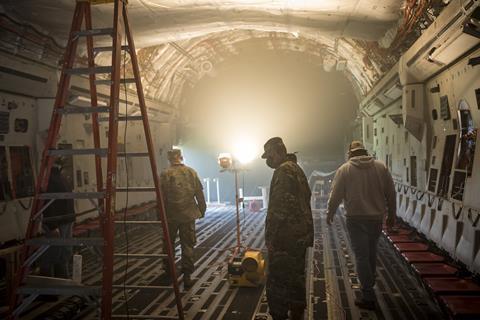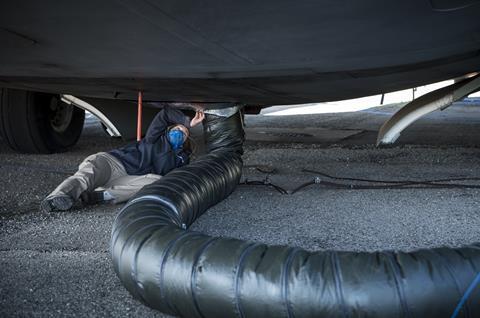The US Air Force Research Laboratory (AFRL) has shown that common ground heaters could be used to raise the temperature of aircraft interiors to levels sufficient to kill the coronavirus and other biological contaminants.
In two tests conducted in May 2020, the interior of a Boeing C-17 cargo aircraft was sealed using materials common to military installations and was heated to 27°C (50°F) above ambient temperatures over a six-hour period, says the AFRL on 9 June. The heaters used in the experiment are found at all military bases, and are commonly used by maintenance crews to keep warm or to heat equipment.

“Our goal with this test was to demonstrate the ability for any Air Force base to assist with aircraft disinfection utilizing only commonly available equipment and materials,” says Doug Lewis, team lead of the 711th Human Performance Wing Protection Systems, which is leading the effort. “We knew that if we could prove the ability of this equipment to heat aircraft interiors to temperatures in the [49°C] range, we were potentially demonstrating an Air Force-wide disinfection capability, pending further laboratory results.”
Aircraft heating could be reapplied to commercial airliners or business jets, providing a cheaper and more effective means for cabins to be disinfected. However, the six-hour period used in the experiment would likely be too time consuming during normal airline operations as aircraft are often expected to turn around within less than an hour.
Airlines and charter operators currently use a variety of methods to clean aircraft cabins including spraying disinfectant and using strong UV lights to kill viruses that may linger on surfaces after infected passengers leave their seats.
The AFRL is working with research organisation Battelle to measure the effectiveness of heat to inactivate the coronavirus. Early results appear promising, it says.
“Preliminary results from Battelle indicate that the temperatures reached during the AFRL tests were sufficient to disable the virus to safe levels on surfaces materials including aluminum, silicon, and nylon webbing,” says the AFRL. “In addition to reaching otherwise inaccessible surfaces, controlled heat disinfection will not adversely impact electronics and sensitive equipment, as some disinfectants might.”

The laboratory is developing recommended implementation procedures. It is also looking at ways to perform the procedure in heated hangars if it proves difficult to raise the temperature of the aircraft interior past the virus-killing threshold otherwise.
Additional tests are planned.
“The future tests will look into the effectiveness of heating the interior for less than six hours as well as the effects of various ambient humidity and temperature conditions,” says the AFRL.
The AFRL has developed aircraft heat disinfection methods before, including a Joint Biological Aircraft Decontamination System (JBADS) that uses heat and humidity.
“This system encloses an aircraft fully, like an aircraft ‘oven,’ heating to temperatures of [60°C] to [82°C] and disinfecting the entire interior, including difficult-to reach surfaces. The JBADS team has also achieved success in optimizing the system to eliminate the COVID-19 threat,” says the AFRL. “However, since this process involves highly-specialized equipment, JBADS is not widely available enough to be used immediately as a go-to solution for the COVID-19 disinfection across the entire military aviation community.”
The laboratory says it is also looking at other means to eliminate coronavirus including airing out aircraft cabins between flights, chemicals, common soaps, household cleaning items, ionization, and ultraviolet light.
Correction: This article was changed on 11 June to reflect the correct temperature difference conversion.































